Physical Chemistry
2nd Edition
ISBN:9781133958437
Author:Ball, David W. (david Warren), BAER, Tomas
Publisher:Ball, David W. (david Warren), BAER, Tomas
Chapter1: Gases And The Zeroth Law Of Thermodynamics
Section: Chapter Questions
Problem 1.32E
Related questions
Question

Transcribed Image Text:А.
Under what conditions of temperature and pressure does a real gas approach ideal
behaviour?
B.
A 7.16 g sample of an anhydrous aluminium chloride produces 1.00 dm³ (10³ m³) of
vapour at 180° C and a pressure of 1.01 x 10° Pa. What is the molecular mass of
aluminium chloride under these conditions?
Use the data given at B. to predict whether anhydrous aluminium chloride is ionic or
covalent in the vapour state. Give a reason for your prediction.
С.
Aluminium fluoride does not melt until the temperature is above 1 200° C. Suggest
reasons for the difference in melting points between aluminium chloride and aluminium
fluoride.
D.
E.
Use sodium chloride and copper to:
i. explain what is meant by an ionic and metallic bonding (use suitable diagrams).
ii. compare electrical conductivities of both in terms of structure and bonding.
Expert Solution
This question has been solved!
Explore an expertly crafted, step-by-step solution for a thorough understanding of key concepts.
Step by step
Solved in 2 steps

Knowledge Booster
Learn more about
Need a deep-dive on the concept behind this application? Look no further. Learn more about this topic, chemistry and related others by exploring similar questions and additional content below.Recommended textbooks for you

Physical Chemistry
Chemistry
ISBN:
9781133958437
Author:
Ball, David W. (david Warren), BAER, Tomas
Publisher:
Wadsworth Cengage Learning,

Chemistry: An Atoms First Approach
Chemistry
ISBN:
9781305079243
Author:
Steven S. Zumdahl, Susan A. Zumdahl
Publisher:
Cengage Learning

Chemistry
Chemistry
ISBN:
9781305957404
Author:
Steven S. Zumdahl, Susan A. Zumdahl, Donald J. DeCoste
Publisher:
Cengage Learning

Physical Chemistry
Chemistry
ISBN:
9781133958437
Author:
Ball, David W. (david Warren), BAER, Tomas
Publisher:
Wadsworth Cengage Learning,

Chemistry: An Atoms First Approach
Chemistry
ISBN:
9781305079243
Author:
Steven S. Zumdahl, Susan A. Zumdahl
Publisher:
Cengage Learning

Chemistry
Chemistry
ISBN:
9781305957404
Author:
Steven S. Zumdahl, Susan A. Zumdahl, Donald J. DeCoste
Publisher:
Cengage Learning


Chemistry: Principles and Reactions
Chemistry
ISBN:
9781305079373
Author:
William L. Masterton, Cecile N. Hurley
Publisher:
Cengage Learning